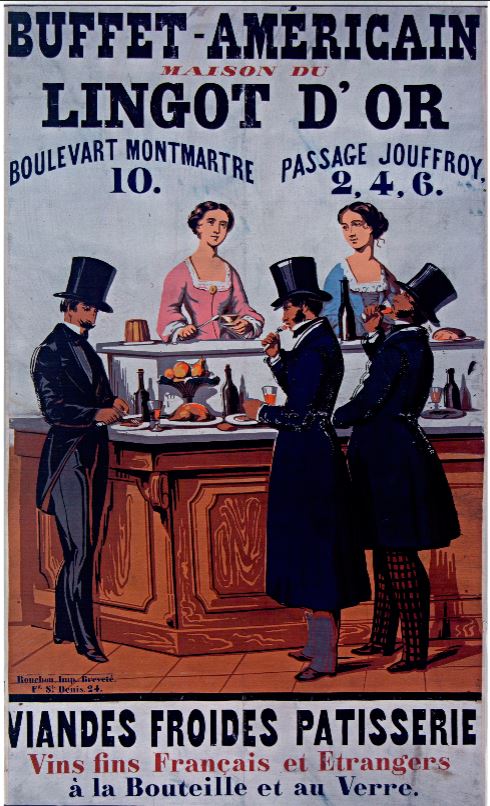Buffet-Américain
By Peter Szende
The Great Exhibition of the Works of Industry of all Nations – also known variably as the Great Exhibition, the Crystal Palace Exhibition, or the World’s Fair – occurred in London during 1851.
This established the standard for industrial and cultural exhibitions throughout Europe and the United States during the next century. It also inspired Napoleon III to organize his Exposition Universelle des produits de l’Agriculture, de l’Industrie, et des Beaux-Arts de Paris (translated as Universal Exhibition of Products of Agriculture, Industry, and Fine Arts of Paris) in 1855.

The Paris Exhibition was a catalyst for the creation of numerous related exhibits, attractions, and businesses in the neighborhoods surrounding the exhibition grounds along the Champs-Elysées. One of these was an innovative restaurant concept portrayed in the vintage advertising poster that is reproduced on a following page. The restaurant does not have a single name in the modern sense, but rather is identified by its style of service and its location.
A buffet-Américain (American buffet) was a place where one could eat or drink while standing. The phrase referred to the growing popularity of impromptu snacking in nineteenth century America, and represented a cross-cultural dining fad that complemented the themes of the Exposition Universelle.
This particular establishment resembled an integration of two concepts that are familiar today, a fast-casual bakery café and an Italian enoteca (wine bar) with standing counters. The text at the bottom of the poster reads “VIANDES FROIDES PATISSERIE” (cold meats and pastries) and “Vins fins Français et Etrangers à la Bouteille et au Verre” (fine wines from France and abroad by the bottle and the glass). The food aspects targeted passersby and a neighborhood business crowd by offering gourmet “sandwiches with ham, poultry wings, and galantine placed between two slices of tender bread slices” (Villemot, 1858). The beverage aspects appealed to the popular urban trend of people socializing over a large selection of wines and other alcoholic beverages by the glass. One observer noted that the place served premium Allsopp beer “either bottled or on draught” (Sala, 1882).
This restaurant was located in the “MAISON DU LINGOT D’OR” (home of the gold ingot) in the Passage Jouffroy, which was a fashionable shopping arcade along the Boulevard Montmartre. The space had previously served as headquarters for a government lottery, which awarded a gold bar valued at more than 400,000 francs.
The poster was created in the workshop of Jean Alexis Rouchon, who is regarded as a pioneer in commercial graphic design in France. He is particularly known for advertising posters of this type, several of which are included in the collection of the Bibliothèque nationale de France (National Library of France or BnF).
Although this buffet-Américain attracted some attention, the business eventually disappeared from the Paris restaurant scene. This Rouchon poster exemplifies commercial art of the era, and also provides a glimpse of a short-lived dining concept that was ahead of its time.
